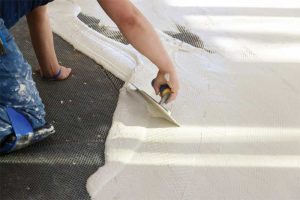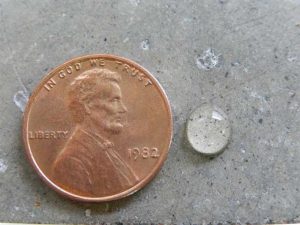
by Dean E. Craft, DBA, CSI, CDT, LtCol USMCR (ret.)
Often referred to as substrate “porosity,” substrate surface water absorptivity refers to the ability of a flooring substrate surface to absorb liquid relatively quickly. To better conceptualize, imagine a concrete masonry unit (CMU) block. If a drop of water was placed on the CMU, it would absorb the liquid very quickly. Now, imagine a hard, smooth surface such as steel, existing resilient flooring, or power-troweled concrete, all of which could serve as the substrate for many different flooring products. If a drop of water was placed on any one of those surfaces, it would sit there and likely evaporate before being absorbed.
Historical context
Why is this of concern for porosity and how that relates to a successful flooring installation? Before addressing this question, it is helpful to provide some historical context. In the 1970s, concerns were raised about indoor air quality (IAQ). The apprehensions grew in the 1980s, and eventually, encompassed the flooring industry, too.
On January 11, 1990, the National Federation of Federal Employees (NFFE) petitioned the Environmental Protection Agency (EPA) under section 21 of the Toxic Substance Control Act (TSCA) to start rulemaking proceedings and focus on reducing emissions from new carpets.
While EPA opted to not initiate the specific rulemaking proceedings it decided to “… initiate a series of actions designed to assess and, if necessary, reduce the public’s exposure to compounds which may off-gas from carpeting.” Upon mutual agreement with EPA, the Carpet and Rug Institute (CRI) agreed to conduct total volatile organic compound (TVOC) emission testing on various materials, and reported the results to EPA’s Office of Toxic Substances in the “Carpet Policy Dialogue Compendium Report,” published in September 1991.
Following closely on the heels of the compendium report, CRI launched a Green Label program in 1992 to test carpet, cushions, and adhesives to help design professionals identify products with low VOCs. This resulted in a fundamental, rapid, and fairly radical change in the formulation of many of the adhesives and other constituent components used for flooring.

Photos courtesy ISE Logik
New adhesives versus old
There is a common belief the ‘good glues’ or flooring adhesives of times past were insensitive to concrete substrate moisture. That is actually not true, and there is literature going back to the 1950s discussing this very topic. Building on that misconception, many believe the ‘newer, water-based’ adhesives, developed for their low VOCs, are the primary source of flooring installation issues. Historically speaking, the ‘newer’ glues are not really new anymore—many of them began their evolution almost 30 years ago. Further, over that time, there have been untold millions of square feet of very successful installations. However, there is a fundamental difference between many of those older adhesives and the newer ones, especially in how they behave once applied to a substrate surface. For example, wet-set water-based adhesives necessitate water loss through evaporation and/or absorption into the substrate for adhesive strength development. In contrast, a moisture-cured adhesive absorbs moisture from the air or substrate for strength development. Knowing whether the concrete surface is porous or not prior to the application of an adhesive and using the appropriate installation methods for the specific porosity conditions are crucial for a successful and durable floorcovering installation.
What drives surface porosity?
A major determining factor of substrate surface porosity is the density of the material. A common substrate for many flooring installations is concrete. In its fresh state, concrete is basically a suspension of solids in water. As consolidation occurs, the denser solids, such as large aggregates, settle. This settling, or displacement, pushes residual mix water, sand, and cement fines upward toward the surface in a process known as bleeding, which is also the process that results in the “cream” at the surface of newly placed slab. Bleeding of the free water continues until the cement paste has hardened enough to finish the sedimentation process, and often results in sheen of liquid water on the surface of the slab. Final troweling of the concrete slab surface is not supposed to occur until the concrete has set and bleeding has stopped; doing so could lead to other surface issues, such as dusting, and a weakened surface layer.
There is no definitive amount of time it takes for the bleed process to finish, as it is the result of a multitude of factors ranging from the concrete mix design to the project site environmental conditions. The amount of water in the initial mix is normally the largest driving factor and mix designs with higher water to cementitious material (w/cm) ratio, all other factors held constant, will bleed longer than a similar mix design with a lower w/cm. Mix designs with various fine supplementary cementitious materials (e.g. fly ash or silica fume) will likely bleed slower than similar mixes without such materials. Various admixtures and fibers can also significantly alter bleed rates. Air movement and temperature and ambient environmental humidity also impact bleeding, and subsequent evaporation of surface water. For example, on windy days or when temperatures are hot, or when the ambient humidity is very low, the bleed water may not even be noticeable since the evaporation rate might be greater than the bleed rate. As a result of all these factors, and more, the time from concrete placement to setting and the stoppage of bleeding, could be anywhere from 20 to 30 minutes to several hours.




